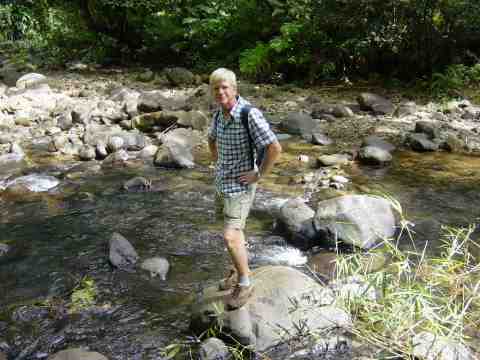Anse de Ste Anne, Martinique

We are anchored about 1 mile southwest of where we were this time last week but have covered quite a few miles in the interim but mainly on four wheels. We finished most of the outstanding jobs on Oriole and slipped into the marina at Marin on Tuesday morning. We picked up a hire car and motored up the east coast to François where we had booked into a wonderful sounding hotel, for one night only, at a price which should have guaranteed something really special. It certainly looked wonderful and the room had fabulous views over the islands and reefs off François with the tradewinds blowing straight in through the balcony window. Unfortunately the service did not live up to the promise and even Basil Fawlty would have been embarrassed that having accepted a booking for dinner the cook did not materialise. Madame offered to get us a takeaway but we felt that even Basil would have rolled up his sleeves and gone into the kitchen. We went off in a huff to a nearby restaurant and the following morning demanded and got an appreciable discount, but even so felt we had been ripped off. The day however was made, at least for John, as we had planned a walk round the Caravelle Peninsular to the Cul de Sac Tartane where Troubadour had anchored with Stuart, John and Paul, accompanied at that stage by Annabelle, 31 years ago. It was undoubtedly one of the best anchorages of that trip. The area is now a national park and the area, then totally wild, is now marked with walking trails through the mangroves and around the bays. Approaching the spot where Troubadour anchored, there appeared out of the mangroves two very attractive young ladies who had just covered themselves from neck to toe with mud. John could not believe his luck when they asked him to take a photograph of them and managed to engineer much difficulty with the camera before the job was finished. The following day more walking was planned along the Beauregard Canal, which runs through the rain forest in the northern mountainous part if the island. This is actually not a canal but a small aquaduct very reminiscent of the Dartmoor leats and built in the 1700s by slaves to take water to a sugar factory. It is built along the sometimes precipitous sides of a valley and in places you have to walk along the retaining wall of the canal no more than 18 inches wide with a sheer drop on one side and the canal on the other. Not a place for an attack of vertigo. The little auberge at one end of the canal was delightful and we had a great evening with the proprietor and his English wife and the only other guest, a Swiss drug company freelance advertising consultant. The place was right in the rain forest and the only sounds were those of the forest and the river tumbling over boulders deep in the ravine below. The locally farmed freshwater crayfish were delicious and were washed down initially with wine but subsequently with a selection of local rums. The fresh mountain air must have cleared our heads during the night as we were up early to walk the Jesuits Trail which takes one through what is apparently one of the best examples of unspoilt tropical rain forest down to the Lorraine River where there are some lovely pools for swimming.

In order to get there we
had had to pass and repass a stretch of road through the mountains which was
signed as closed, “danger de mort” and only to be passed by “vehicules de
secours authorisés” We
were just about to turn back when a car came in the opposite direction and the
driver assured us that there were no problems. We were later told that the local
authorities were fools and that the reason for this hysteria was that a man was
killed in a landslide four years ago while cutting trees after a prolonged
period of very heavy rain. There
had been no problems either before or since. Why do the French make crazy rules that
no-one obeys except perhaps the English?
The final night of this little holiday from the boat took us to
Plantation Leyritz , an old banana and sugar plantation which was converted some
years ago into a hotel where the rooms have been provided in the restored slaves
houses and the public rooms in the restored ruins of the plantation
buildings. The once luxurious
Planters House, now awaiting restoration, is set on a hill overlooking the
plantation, still very actively farmed with bananas, looking eastwards to the
Atlantic and cooled by the tradewinds.
The place gave us an interesting insight into the lives of the plantation
owners and workers and the grandeur of the lives of a very few. Our final day of walking took us to St
Pierre where , on the 8th May 1902,
the population of 30,000 were killed within a few minutes, all but one
man, when Mt. Pelée exploded and showered the town with hot ash and sulphurous
gases. Our final walk in the
mountains, carefully followed from our walk book, turned into a squirrel track
and ran up a tree, so we thanked our stars that this tends not to happen at sea
and returned to Oriole and are now happily at anchor again awaiting our passage
to St Lucia on Tuesday.